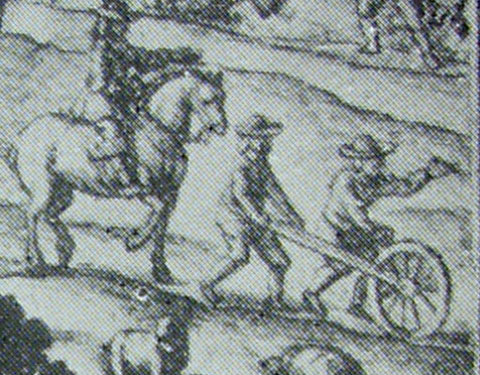
Here you can see the surveyor pushing the familiar measuring wheel, as the distances along the roads were measured.
What is really interesting is the authors comments about the use of the waywiser,
"A Word or two of Dimensurators or Measuring Instruments, whereof the most usual has been the Chain, and the common length for English Measures 4 Poles, as answering indifferently to the English Mile and Acre, 10 such Chains in length making a Furlong, and 10 single square Chains an Acre, so that a square Mile contains 640 square Acres; This, as it obliges the Surveyor to chargeable Assistances, so it exposes the Account to the Dangers of Mistakes, which, perhaps is not the least Reason of the slow Progress of Actual Dimensuration, even in these last Centuries; That We have been much facilitated therefore in this Great Work by the Wheel Dimensurator, which, for Ease and Accurateness infinitely surpasses the Chain, as being manageable by a single Person, Measuring, even the smallest Deviations of the way, and finishing a Revolution but once in 10 Miles; We readily acknowledge, and even in Wheels themselves, commend rather the Foot-Wheel here mention'd, of half a Pole Circumference, with the Way-Wizars as they are now Regulated, than any such like Coach or Chariot-Mensurator whatsoever." John Ogilby, 1675.
Ogilby's statement that one revolution (of the distance indicator dial) corresponds to 10 miles, proves to my mind that this was a geared device similar to that shown on the front cover of MN 34 (Thanks Pete for finding that) and also an earlier version of the geared system used by George Everest in the Survey of the great Arc in India in C19.See my post of Jan 2008
The geared counter of Alan Jones (and now of Tom Riegel) has an interesting history. Hugh Jones has suggested that I should write something about it for a course measurement website. Any contributions and ideas will be gratefully received - and duly acknowledged if I do get something put together.
I am amused by Ogilby's observation that the need for assistants in the chaining method exposes the surveyor to mistakes. Then as now, the geared wheel helps a lot to avoid measuring mistakes.
